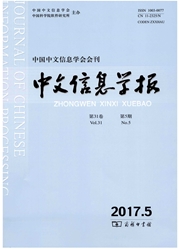

 中文摘要:
中文摘要:
该文首先介绍了鲁东大学进行的语义构词研究,说明了"无向型名词"的所指;进一步运用物性结构理论,分析语素义转指的六种类型,并提出结合转喻、隐喻、转隐喻理论共同解释"无向型名词"词义构成的研究方法;根据两个语素义如何通过转喻或隐喻转化为词义,将无向型词语分为八类。根据物性结构理论,具体分析无向型词语的语素义体现了哪种物性角色,语素义与词义是什么关系,语素义是基于相关性发生转喻还是基于相似性发生隐喻。最后总结了语素义整合转化为词义的特点,八种类型中前项—后项转喻(包含整体转喻)、前项—后项隐喻(包含整体隐喻)数量最多,符合人类普遍认知规律。
 英文摘要:
英文摘要:
From the perspective of semantic construction,this paper explains the denotation of undirected nouns.It further proposes six types of connotation of nouns according to qualia structure theory,and tries to interpret the semantic construction of undirected nouns by metonymy,metaphor and metaphtonymy.According to the way to transform the morpheme sense into word sense,undirected nouns are further classified into eight types.Based on qualia structure theory,we investigate which qualia role of a morpheme will be integrated into the meaning of the whole word.Finally,we summarize the rules of mapping from morpheme sense to word sense,indicating that prevlast metonymy and prev-last metaphor are most popular.
 同期刊论文项目
同期刊论文项目
 同项目期刊论文
同项目期刊论文
 期刊信息
期刊信息
